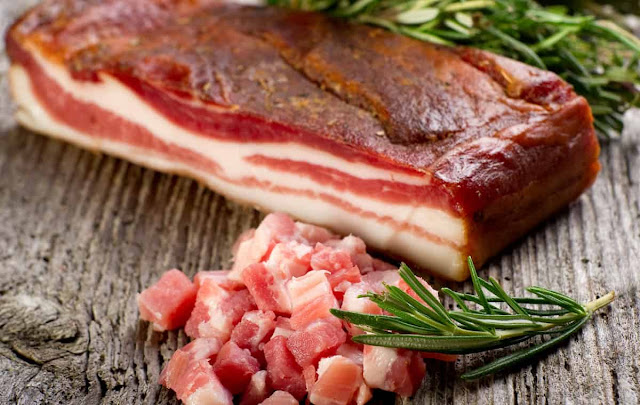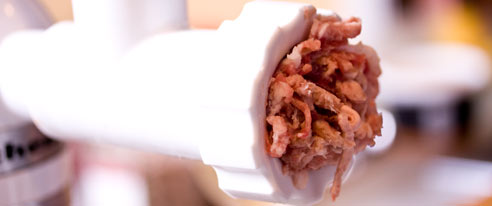Ham, Bacon & Gammon
Ham, Bacon & Gammon
Ham
Ham is the cured hind leg of a pig, smoked or salted and smoked to preserve it. Ham that are dry salted has the best flavour and are the most tender but other hams are plunged straight into brine, or cured in a way that combines both methods. Curing time can as long as 2 months. Salt used for curing is usually mixed with sugar an assortment of spices, particularly pepper and with nutritive preservatives that add Pink colour and protect meat from botulism toxins. The feed given to the Pig affects the taste of ham, the peanuts of virgin, and the peaches of Georgia; all contribute to flavour & texture. After salting the ham may be smoked over fragrant woods such as apple, beech and hickory, then it is left to age for 3 months to 2 years. The atmosphere must be cool and dry, many famous ham’s are cured in mountain regions. A cured ham (often called a Country or home cured ham) may weigh as much as 20 lb but small or medium hams up to 15 lb are less likely to be fatty. Some hams like the famous Parma ham are intended to be eaten raw in thin slices and are often accompanied by fresh fruits such as melon or figs or delicate vegetables like Asparagus. Many ham bought raw, however need to be simmered before being served. The day cured and salty whole hams should be soaked in cold water for several hours, before simmering. Some hams are sold pre-cooked these may be served plain or cooked further and are eaten either hot or cold. The saltiness of a plain cooked ham is complemented by sweet accompaniments such as fruit chutney and apple sauce.
Ham is meat cut
from the thigh or rump of the pig. Ham can be cooked and served fresh or wet or
dry cured usually with less salt and more sugar.
Types of ham vary between countries. In Italy cured or cooked ham is called Proscuitto; in France wet-cured boneless ham is called Jambon de Paris; Parma ham from Italy uses little salt and includes sugar and garlic salt to cure it sealed with pig fat to slow the drying; in Spain Serrano ham comes from white pig; tinned ham common in the US is smaller cuts of meat sold in tins with aspic jelly.
Ham is commonly
used as slices in salads and sandwiches. On special occasions such as
Christmas, a Christmas Ham which is a whole leg of ham is studded with cloves
and coated with a sugary maple coating and baked before slicing.
Commonly
Used Hams
2. Smith field
3. Virginia
4. Sugar baked
5. Bayonne
6. West Phalian
7. York
8. Black Forest
9. San Daniele
10. Brunswick
11. Coppa
12. Serrano
13. Parma
Bacon is meat taken from the back, loin or belly of the pig. Bacon is either dry cured in cold air or by smoking or packed with large amounts of salt, or wet cured when it is immersed in liquid brine.
Bacon can be fried, grilled, boiled, smoked or baked. It can be chopped
into 'bacon bits' and used as a topping for many dishes including pizza and
salad. Bacon is also wrapped around other meat such as chicken breast to impart
fat and flavor. Bacon lard or fat is used for basting roasting meats. Bacon is most commonly eaten as slices or 'rashers' in
sandwiches or for breakfast with eggs and toast.
Gammon
Gammon is the
hind leg of pork after it has been cured by dry-salting or brining, which may or may not be smoked. Unlike most ham, but like bacon, it must be
cooked before it is safe to eat. The term is mostly used in Britain, while
other dialects of English largely make no distinction between gammon and ham.
Ham hock, gammon hock, or knuckle, is the foot end of the joint, and contains more connective tissue and sinew.
Old French jambon is attested since the 13th century and is derived from Old French jambe (gambe in Old North French) which in turn is derived from the Late Latin gmaba, meaning 'leg/hock of a horse/animal', which can ultimately be traced to Greek kampe meaning 'a bending/a joint', which is from Proto-Indo-European *kamp- (“to bend; crooked”). In some English dialects a similarly derived 'gambol' refers to a 'leg'.







Thank you for notes sir
ReplyDeleteWell briefed.. 👍
ReplyDeleteGreat sir🙏
ReplyDeleteBrilliant
ReplyDeleteWell explained
ReplyDeleteTanvi agarwal
Well explained notes sir.
ReplyDeleteThank u
Brilliant
ReplyDeleteinformative
ReplyDeletethank you sir!
ReplyDeleteWell explained notes .
ReplyDelete~rahul bhardwaj
Great knowledge
ReplyDeleteRegards- Varchasva Bhardwaj
Well defined and informative
ReplyDeleteThank you sir for clearing our doubts on these topics.
ReplyDeletePork->Ham->Gammon.
ReplyDeleteThanks for the notes sir
ReplyDeleteThanku sir!
ReplyDeleteThank you Chef ....
ReplyDeleteThankyou sir
ReplyDeleteThankyou chef
ReplyDeleteWell explained sir
ReplyDeleteThank you sir for information
ReplyDeleteThankyou sir
ReplyDeleteThank u sir
ReplyDeleteThankyou sir
ReplyDeleteVery informative
ReplyDelete👌👌👌👌👌
ReplyDeleteThankyou so much sir for the notes
ReplyDeleteInformative notes sir.
ReplyDeleteThank you.
💙 thank you sir
ReplyDeleteThank u sir
ReplyDeleteThanks sir
ReplyDeletethankyou so much sir
ReplyDeleteVery good
ReplyDeleteAll the notes are very informative...thank you sir
ReplyDelete